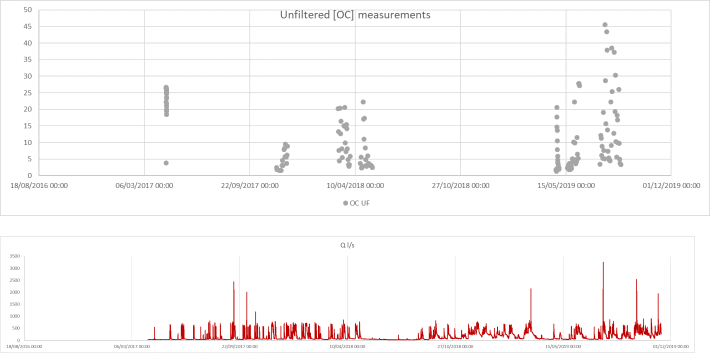Measuring and Predicting AOC and AOC PS flux
Hello, dear friend, you can consult us at any time if you have any questions, add WeChat: daixieit
Measuring and Predicting AOC and AOC PS flux
Measuring AOC flux
Measuring AOC >0.2um and <0.2um flux
Available measurements (approximate for each site)
During 3 year period
200 [OC] measurements at 24 hour resolution
110,000 Q measurements at 15 minute resolution

How best to use these measurements:
1. Interpolation over time across monitored periods
o [OC] was measured, therefore reliable
o But only once per day
o <180 measurements of [OC] spread unevenly over 3 years
o Calculate and compare flux in each period to show variability
o Calculate average flux over all periods, compare to flux calculated in (2)
calculation_interpol_over_time
2. Produce rating relationship by interpolating over discharge
o Develop rating relationship; error on [OC] may be high
o But Q is measured at high temporal resolution spread over full 3 year period
o Flux can be calculated over a long period - whole period of monitored Q – therefore integrating as much variability as possible.
o Apply rating relationship to calculate [OC] through complete 3 year Q record
o Multiply Q x [OC] to give long term average AOC flux
3. Validate methods by comparison
4. Use high temporal resolution monitored periods e.g. time series (hourly) data during discharge event, to recognise processes that cause rating relationship to fail; primarily time dependence (change in rating relationship over time because of changes in OC availability).
5. Suggest more sophisticated model and further work / input data required.
Measuring flux of colloidal size classes of AOC
Available measurements (approximately for each site)
During 3 year period
Only 11 – 21 particle size distributions (PSD) were produced and their [OC] analysed
How best to use these measurements:
· Too few samples spaced too far apart to interpolate over time
· A rating relationship is based on the assumption that concentration is controlled by Q. In this case the relationship must summarise the control by Q of both concentration and size. The relationship is unlikely to be linear.
· Given that, even for the relationship between Q and [OC] there is large scatter, primarily because of time dependence, there are too few PSD [OC] samples to allow a non-linear relationship to be recognised as significant.
· Interpolation over discharge (rating relationship) – can be done by:
o Arbitrarily classifying Q into ranges and averaging [OC] of size fractions within these ranges
o This averaging reduces the scatter
o But because the selection of Q classes was arbitrary, sensitivity of the results to the selection must be tested – more than one set of classes must be made and the resulting fluxes compared between selections.
calculation_PSD_interpol_over_Q
Calculations and ssheets
1. Calculate AOC flux by interpolation over time Video interpol over time
· There are 7 periods of daily concentration measurement at each site. For each period interpolate between daily concentration measurements (Sampled periods & fluxes sXX 2017-2019.xlsx)
o Compare forward, central and backward interpolation
· Compare variability of these measurements between periods. (Make a table of results for each period)
o Is a common flux apparent? Give best estimate of flux and error (range of values calculated)
o Calculate the average flux from all the periods and include the total number of days over which measurements were made.
Fluxes calculated from these periods of interpolation can also be used to test rating relationships that predict concentration (flux) from discharge (see 2. Below):
2. Calculate AOC flux by interpolation over Q (rating relationship)
M&P part 1 Rating Relationships
· Construct a rating relationship
o Plot all OC against all Q data (Q v OC rating 2016-2019.xlsx)
o Try to improve the relationship of [OC] to Q by making more than one relationship.
· Use the relationship / relationships to calculate flux from discharge throughout the whole period Video - Using the rating relationship . The complete Q record is in these ssheets Flow Duration s50.xlsx, Flow Duration s60.xlsx. Q is arranged in order of magnitude so it is easy to apply different rating relationships to ranges of Q e.g. high and low.
· In a similar way, you can predict future AOC flux by applying your rating curve to a future Flow Duration curve generated from your computer model of the catchment and a prediction of future rainfall. Predicting_AOC_flux
· Test the relationship / relationships by using them during the periods during which [OC] measurements were made and comparing the results from interpolation over these time periods Sampled periods & fluxes sXX 2017-2019.xlsx (add the fluxes calculated from rating relationships to your Table of interpolation over time results).
· Comment on - How predictable is the flux (concentration) from discharge?
o Use the high temporal resolution (hourly) OC v Q data to explain why the error on the rating relationship may be high.
3. Calculate AOC PS flux by reducing dataset and interpolation over Q
· PSD flux ssheet MPEC NOM PSD Flux Student.xlsx
· Select arbitrary Q classes
· Average [OC] of PS classes within each Q class
· Multiply the average [OC] in a Q class by the volume of water discharged within the Q class Flow Duration s50.xlsx, Flow Duration s60.xlsx.
· In a similar way you can predict future AOC PS fluxes by extracting volumes of water discharged from a future Flow Duration curve generated from your computer model of the catchment and a prediction of future rainfall. Predicting_AOC_flux
Physical model
· Compare the Measured fluxes from uneroded and eroded catchments.
Computer model
· Create a model of the catchment and input a future rainfall.
· Output a future flow duration curve
o For future AOC flux: Apply your rating relationship(s) to this future Q to calculate future average flux g/m2/day
o For future AOC PS fluxes: Extract water volumes discharged in each of your Q classes and multiply them by the [OC] of each PS.
2023-09-02